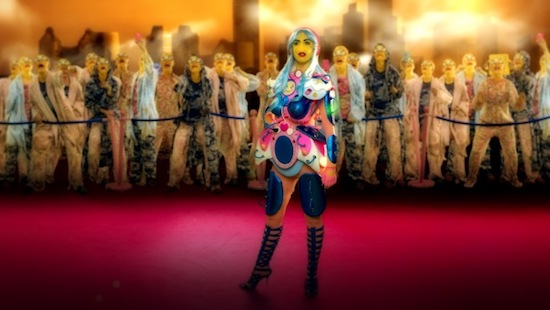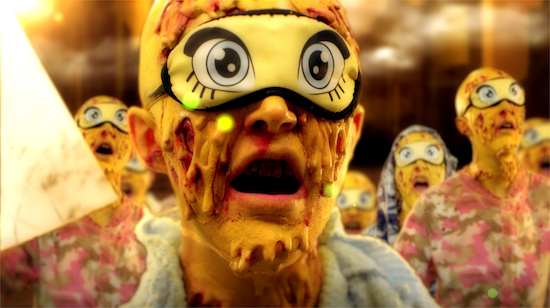It’s What’s Inside That Counts, Digital still – courtesy of the artist. Commissioned HOME, University of Salford Art Collection, Tate, Zabludowicz Collection, Frieze Film and Channel 4
Last year, I was drawn in to Manchester’s contemporary art centre, Home, by the satirical fashionably infantile imagery on the poster for Wot u 🙂 about?. Wot u 🙂 about? included Rachel Maclean’s green screen collage film, It’s what’s inside that counts, along with other works by her, demonstrating the link between the societal pressures we face daily from marketing and each other through our cyber lives and identities. Equally enchanted and perturbed by the juxtaposition of these contemporary fairytale narratives and familiar Poundland-princess colour schemes shown in the art work, I was thrilled to hear she was coming back.
This year, fresh from representing Scotland at the Venice Biennale, Maclean came to Salford University’s New Adelphi Building to discuss her latest digital film, Spite your face alongside other works. During the talk Rachel spoke about how the recent shifts in society, technology and politics had influenced her most recent collection of grungy yet candy-coloured films and prints. During a short Q&A after the talk, she explained how green screen was an intrinsic part of her art and that it had allowed her more freedom to create new worlds, characters, and their warning-label narratives.
Following this, I was riddled with questions to find out more about the influences, processes, and barriers Maclean had come up against whilst reflecting these relevant, and very real nightmares into plastic dreamlands. And, I was lucky enough meet Rachel to ask them.
You’ve got such a varied background in both digital video and print, and you also play all the different characters in your videos. Which was your first creative outlet – performance or visual art?
When I was at college I was into performance art and the tradition of performance where you are in your own work. I guess it started from that, like; “okay I’m here, so this is an easy way to start making videos!” and it developed from there. I’ve always loved dressing up!
Being different characters and convincing people of an illusionary world meant that discovering how to use green screen as a medium was very exciting. It felt like what you could do in collage and in painting I could now bring into video. It’s no longer a medium where you need a stage set.
All the characters in your work seem to be transient, changing from ‘goodies’ to ‘baddies’ and everything in-between. Often having an understanding of characters can also mean empathizing with them and who/what they represent. Which character you’ve created do you feel you relate to the most?
I don’t think of them as solid characters, they are characters who can shift and are malleable but I probably relate to the female characters the most. The female characters I create have to embody a number of different roles at once; from being a child to a sex object, being a mother to being a professional. I think that’s really the situation for women in society now, you’re expected to perform multiple roles simultaneously whilst being criticised for doing so. Yeah, I definitely connect with the female characters the most. I put a lot of my anger about the position of women and the way women are treated in society into those characters.

It’s What’s Inside That Counts, Digital still – courtesy of the artist. Commissioned HOME, University of Salford Art Collection, Tate, Zabludowicz Collection, Frieze Film and Channel 4
The female character in Spite your Face seems to be all of these things to Pick, the main character in the story. Was it your intention for her to represent all of this in this film or were there other factors?
I wanted to represent women in history, art history, and the idea of the cult of the Madonna.
She feeds into that, the sense of the Madonna being this religious figure but also being a kind of mother figure and people relating to her at that level, as well as the contemporary idea of sexualized women. There’s a scene where she is raped by this Pinocchio character, Pick. By his long phallic nose and it’s quite a violent scene. She castrates him shortly after the ordeal and does so in a quite journalistic way, with an intelligence that she has over him.
I was interested in her being complex, and embodying all these roles and being a powerful figure.
Talking of Pick… I had a hunch that his name was a cheeky reference to people secretly picking their nose! At any point does he Pick his nose?
Haha! No, but he probably should have!
Despite him not picking his nose, it touched on a lot of brilliant topics to do with societal hierarchy, classism, and the way the media works. Whilst you were writing the script, the concept of ‘fake news’ became a hot topic – did that affect the narrative and change what you were writing at all?
Yeah, absolutely. There’s also that feeling as an artist, that we won’t understand the times we’re in, until maybe five years later when we can look back and have some perspective on it. So in a sense, you respond more emotionally to the things that are currently happening. It was a really odd moment where politics shifted very suddenly and unexpectedly, particularly with Brexit. There was a latent political force there that I wasn’t aware of and I think it’s interesting to think how much journalism has changed since Facebook. I’ve been becoming depressed with the idea that this fake news, Facebook effectively – a massive advertising company – is almost single-handedly killing journalism. A platform like Facebook has no morale purpose or intent behind it, a newspaper might sell advertising but there’s some larger purpose. So yeah, fake news sells advertising.
Hopefully, some people will still value journalism over fake news, but obviously the pecking order is constantly shifting and so are the people within it, which your work reflects with the three layers that seem present in the story worlds you’ve created. The concept of a heaven, earth, and hell is quite prevalent in a biblical, fairytale sort of way. What inspired you to include that theme?
It is like a fairy-tale almost, there is something childish about the worlds I create and visually I think I’m interested in contrast – being able to contrast between a world that feels quite plush and a world that is in ruins. I think it’s increasingly the way our society is, living in these bubbles created by social media where you’re only in contact with people who believe the same thing as you do. There’s not the same level of debate between people with different perspectives. There’s an increasing inequality in society but also an inequality between generations. People of a younger generation are coming into a world which is not offering them a hell of a lot. These co-existing worlds feel very separate.
It’s what’s inside that counts includes a very happy male character guru-type, who pressures an unhappy female character to keep chanting mantras and pushing herself to her limits. She does this with the aim of making herself pure and beautiful externally and internally. This is a pressure we all face daily now with social media and advertising. One particular social media trend I’ve noticed is the hashtag #selfcare. It started off with good intent and just meant for people to take some time out for themselves in quite a hectic world. It now seems to have been manipulated by businesses that sell expensive luxury items, which people will photograph or selfie with so that even their own downtime now needs to be aesthetically pleasing so it can be posted about, instead of just enjoying it. It’s created yet another difficult-to-live-up-to online persona. Was it this sort of trend that inspired It’s what’s inside that counts or was it something else?
Yeah it’s that sort of ideal mixed with the recent development of ‘Mindfulness’ in the tech industry. It didn’t come out of Silicon Valley but has been warped into this Silicon Valley thing, which people incorporate into businesses. It’s this kind of meditation where you see the world as entirely relating to your perception. I found myself annoyed at the concept of ‘Mindfulness’ in businesses and schools and what you’re supposed to gain from it. The idea that if you’re angry, if you’ve got problems, you can shift your perception and your problems will seem less or go away. It stops people thinking politically – that maybe you’re not getting paid well? Maybe you’re over worked? Maybe these things you feel are in the world? You need to be angry about them, instead of it being individualistic, to the point it’s just channeled through you and nothing is discussed collectively.
Something you mentioned during the artist talk was your irritation with the Disney-style belief that is pushed on us that ‘if you can dream it, you can do it’. An idea that you explained doesn’t take social economics or personal circumstance into account, consequently meaning we berate ourselves when we don’t succeed, believing that it’s because we didn’t work hard enough or want it enough. In the art world and other creative industries, blood and money count for a lot when it comes down to success. It’s always difficult to give advice, but from your personal experience what do you think is important for other creative people to remember throughout their own work?
I think as an artist, you graduate into a world where you realise it’s not easy to be an artist. I think there’s reasons why it’s not easy in our society, but they’re not reasons why you shouldn’t be an artist. Artists make things that aren’t – in the first instance – commodities. You don’t think of it as something that’s going to sell. You make it for other reasons that are not commercial. Our world is in the process of commodifying and privatising everything. Everything can be bought and sold. You are working outside of that, and it’s not well supported in the current climate, so you do have something to fight against. Regardless, remind yourself of the importance of your art, especially in such a visual culture where we can use this medium to educate each other.


